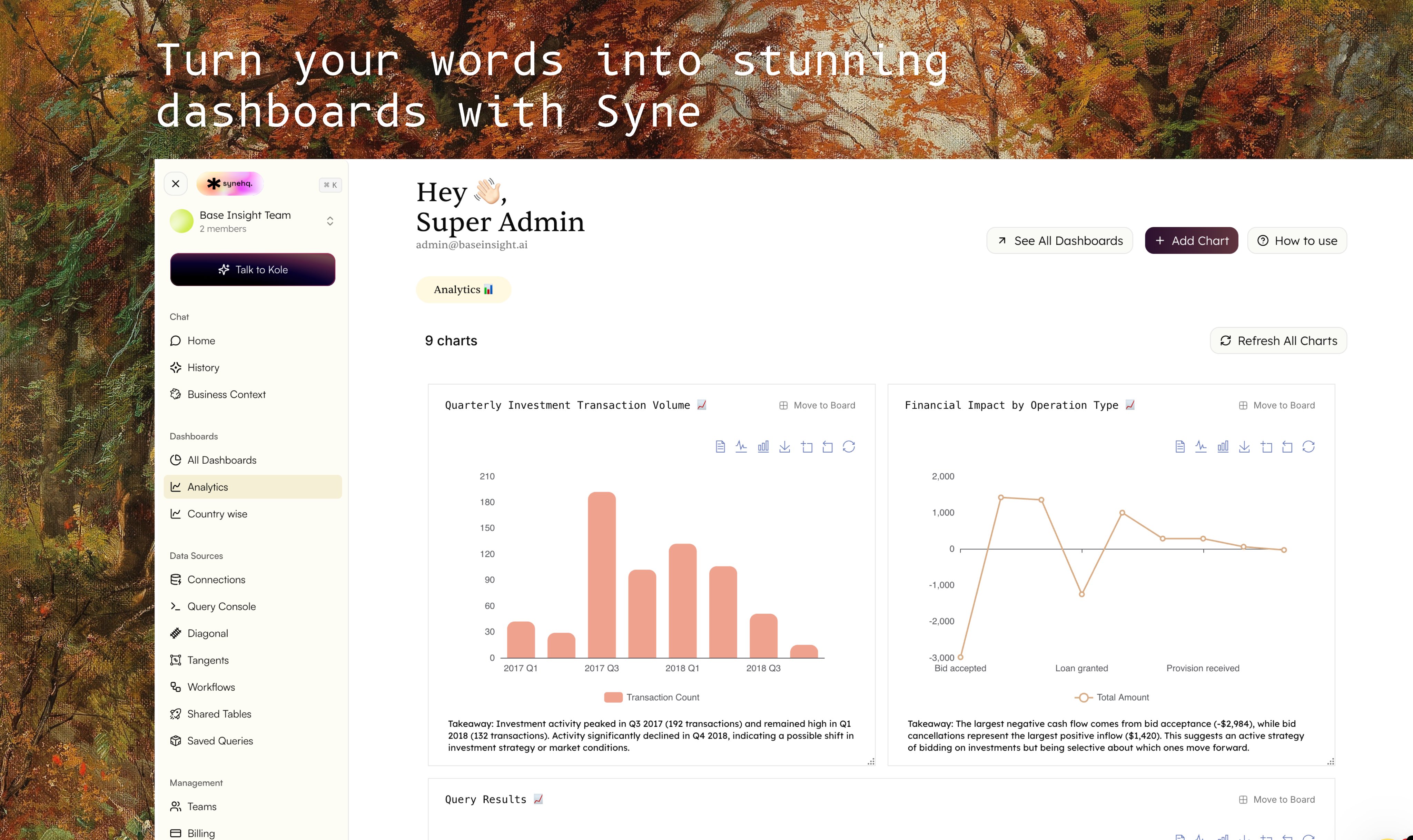Syne turns your words into stunning dashboards and insights—no coding required. This section covers how to build, interpret, and share powerful data visualizations using Syne’s visual analytics features.
- Instant charting: Go from question or query to live charts and insights in seconds.
- Rich outputs: Visuals include bar charts, line charts, pie charts, tables, and more.
- Narrative insights: Each chart comes with automated “takeaway” summaries and context explanations.
- Dashboarding: Arrange, organize, and refresh visualizations to monitor key metrics at a glance.
How to Build Visualizations
-
Ask or Build a Query
- Use natural language (“Show me quarterly investment volume”) or the No-Code Query Builder.
- Review or edit generated SQL for full transparency.
-
Run and Visualize
- Click Run to execute your query.
- Instantly preview results as tables and charts.
-
Choose and Customize Chart Type
- Select from bar, line, pie, or table using the Visualization panel on the right.
- Assign X (dimension) and Y (metric) fields—e.g., Quarter vs. Transaction Count.
-
Automated Insights & Takeaways
- Below each chart, view an AI-generated summary interpreting the trend, anomaly, or correlation.
- Examples: “Investment activity peaked in Q3 2017…”, “Largest negative cash flow from bid acceptance…”
-
Dashboard Mode
- Click Add Chart to organize charts into dashboards.
- Move visualizations onto boards for monitoring by team or use case.
- Use Refresh All Charts to update with the latest data.
-
Export & Share
- Export visuals and data for use in slides, reports, or discussions.
Dashboard

Visualization Types Supported
- Bar Chart: Ideal for time series (e.g., quarterly volumes), category comparisons, and ranking.
- Line Chart: Perfect for trend analysis or visualizing continuous changes (e.g., cash flow impact over time).
- Pie Chart: For proportional breakdowns.
- Table: For detailed, granular output.
- Area Chart: Great for showing cumulative values and part-to-whole relationships over time.
- Scatter Plot: Perfect for correlation analysis and identifying relationships between two variables.
- Composed Chart: Combine multiple chart types (bar + line) to show different metrics on the same view.
- Radar Chart: Compare multiple variables across categories in a circular format.
- Treemap: Visualize hierarchical data with nested rectangles proportional to values.
- Geographic Charts: Display data on maps for location-based analysis and regional insights.
- Sankey Diagram: Show flow and relationships between different stages or categories.
- Heatmap: Reveal patterns and correlations in large datasets through color intensity.
- Funnel Chart: Track conversion rates and drop-offs through sequential stages.
- KPI Cards: Display key metrics with context, targets, and trend indicators.
- Box Plot: Analyze statistical distributions, outliers, and quartile ranges.
- Flexible switching: Instantly toggle between chart types. Icon tooltips describe best uses.
Mapbox Support
 Syne supports comprehensive geographic visualization capabilities through integration with both ECharts and Mapbox/Deck.GL:
Map Types Available:
Syne supports comprehensive geographic visualization capabilities through integration with both ECharts and Mapbox/Deck.GL:
Map Types Available:
- Heatmap: Color-intensity overlays showing data density and distribution patterns
- Cluster: Aggregated point clustering with dynamic zoom-based grouping
- Scatter: Individual data points plotted on geographic coordinates
- Screen Grid: Hexagonal or square grid aggregation for spatial analysis
- Path/Flow: Directional lines showing movement, routes, or connections between locations
- Country Maps: Detailed country-level choropleth visualizations
- World Map: Global choropleth with country-level data aggregation
- Latitude/Longitude Fields: Required for all geographic visualizations
- Country Selection: Needed for country-specific map renders
- Value Mapping: Assign metric fields to control color intensity, point size, or aggregation values
- Dynamic Zoom: Maps automatically adapt detail level based on zoom
- Hover Tooltips: Display data values and location information
- Layer Toggle: Switch between different visualization types instantly
- Export Support: Save high-resolution map images and underlying data
Best Practices & Tips
Best Practices & Tips
- Natural Language + Visuals: Start with simple questions—Syne’s AI interprets intent and suggests the best chart.
- Automated Explanations: Use narrative takeaways to enhance presentations and drive decisions.
- Dashboards: Group essential charts to track KPIs.
- Organization: Use categories, search, and pinned boards for fast access.
- Collaboration: All boards and charts are easily shareable within your team.
Example Gallery
Example Gallery
Quarterly Investment Transaction Volume
- Chart: Vertical bar chart with quarterly time axis.
- Legend: Transaction count.
- Takeaway: Highlights peaks and declines in investment activity.
- Usage: Spot inflection points, market strategy changes.
- Chart: Line chart showing cash flow by operation (bid acceptance, loan granted, etc.)
- Legend: Total amount.
- Takeaway: Identifies the largest positive/negative flows and drivers—e.g., bids, provisions.
“Investment activity peaked in Q3 2017 (192 transactions)… Activity significantly declined in Q4 2018, indicating a possible shift in investment strategy or market conditions.”
“The largest negative cash flow comes from bid acceptance (−$2,984)… This suggests an active strategy of bidding on investments but being selective about which ones move forward.”
FAQ
FAQ
Q: Do I need to know SQL to create charts?
No, Syne’s builder and natural language features allow anyone to build and visualize insights. Advanced users can also edit SQL directly.Q: How do I organize multiple visualizations?
Use Dashboards and Boards to group, organize, and refresh related charts.Q: What if I want to present my findings?
Each chart and its narrative can be exported or embedded in presentations, reports, and emails.Q: Can charts update with new data?
Yes, use Refresh All Charts to fetch the latest numbers across your dashboards.
No, Syne’s builder and natural language features allow anyone to build and visualize insights. Advanced users can also edit SQL directly.Q: How do I organize multiple visualizations?
Use Dashboards and Boards to group, organize, and refresh related charts.Q: What if I want to present my findings?
Each chart and its narrative can be exported or embedded in presentations, reports, and emails.Q: Can charts update with new data?
Yes, use Refresh All Charts to fetch the latest numbers across your dashboards.